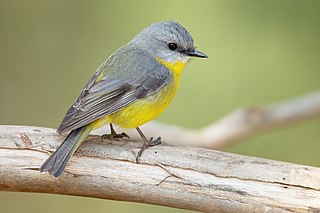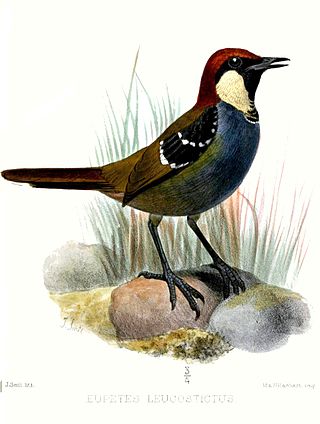
A passerine is any bird of the order Passeriformes, which includes more than half of all bird species. Sometimes known as perching birds, passerines generally have an anisodactyl arrangement of their toes, which facilitates perching.

A songbird is a bird belonging to the suborder Passeri of the perching birds (Passeriformes). Another name that is sometimes seen as the scientific or vernacular name is Oscines, from Latin oscen, "songbird". The Passeriformes contains 5,000 or so species found all over the world, in which the vocal organ typically is developed in such a way as to produce a diverse and elaborate bird song.

Psophodidae is a family of passerine birds native to Australia and nearby areas. It has a complicated taxonomic history and different authors vary in which birds they include in the family. In the strictest sense, it includes only the five or six species of whipbirds and wedgebills, but some authors also include the quail-thrushes (Cinclosoma), eight species of ground-dwelling birds found in Australia and New Guinea, and the jewel-babblers (Ptilorrhoa), three or four species found in rainforest in New Guinea. Others place them in their own family, the Cinclosomatidae. The Malaysian rail-babbler was formerly sometimes placed in this family, which would then be called Eupetidae.

The eastern whipbird is an insectivorous passerine bird native to the east coast of Australia. Its whip-crack song is a familiar sound in forests of eastern Australia. Two subspecies are recognised. Heard much more often than seen, it is dark olive-green and black in colour with a distinctive white cheek patch and a crest. The male and female are similar in plumage.

The lesser melampitta is a medium-sized enigmatic terrestrial songbird of mountain forests of New Guinea. It is the only species in the genus Melampitta. It is now classified in the family Melampittidae, but in some other sources it is variously considered close to or in the Orthonychidae (logrunners), Paradisaeidae, Corcoracidae, Cnemophilidae (satinbirds) or Monarchidae.

The rail-babbler or Malaysian rail-babbler is a strange, rail-like, brown and pied ground-living bird. It is the only species in the genus Eupetes and family Eupetidae. It lives on the floor of primary forests in the Malay Peninsula and Sumatra, as well as Borneo. It is distantly related to African crow-like birds. Its population has greatly decreased because much of the lowland primary forest has been cut, and secondary forests usually have too dense a bottom vegetation or do not offer enough shade to be favourable for the species. However, it is locally still common in logged forest or on hill-forest on slopes, and probably not in immediate danger of extinction. The species is poorly known and rarely seen, in no small part due to its shyness.

Whipbirds and wedgebills are collectively recognised in the genus Psophodes. Wedgebills are divided into the chirruping wedgebill and the chiming wedgebill. Whipbirds are divided into the eastern whipbird and the western whipbird. Subspecies of the western whipbird residing in Western Australia are known to be endangered. Psophodes is a genus of five species of songbirds endemic to Australia, known as whipbirds and wedgebills.

A quail-thrush is a bird of the genus Cinclosoma, which contains eight species. Quail-thrushes are in a different family from either quails or thrushes, but bear some superficial resemblance to them. The genus is found in Australia and New Guinea in a variety of habitats ranging from rainforest to deserts. The genus is closely related to the jewel-babblers of New Guinea. Seven species were recognised in 2007. A molecular study published in 2015 by Gaynor Dolman and Leo Joseph resulted in the splitting of the chestnut-backed quail-thrush into the chestnut quail-thrush of eastern Australia and the copperback quail-thrush in the west.

The chestnut quail-thrush is a native Australian bird of the family Cinclosomatidae. These scrub birds are endemic to Australia and found in all states - barring Tasmania. They are relatively uncommon and are isolated to the semi-arid and arid fringes of the Australian interior.

The spotted quail-thrush is a species of bird in the family Cinclosomatidae. It is endemic to Australia.

The melampittas are a family, Melampittidae, of New Guinean birds containing two enigmatic species. The two species are found in two genera, the greater melampitta in the genus Megalampitta and the lesser melampitta in the genus Melampitta. They are little studied and before being established as a family in 2014 their taxonomic relationships with other birds were uncertain, being considered at one time related variously to the pittas, Old World babblers and birds-of-paradise.

The jewel-babblers are the bird genus Ptilorrhoa in the family Cinclosomatidae. The genus contains four species that are endemic to New Guinea. The genus was once considered to contain the rail-babbler, but that species is now considered to belong to its own family. The genus is closely related to the better known quail-thrushes (Cinclosoma) of New Guinea and Australia. Together with a number of other genera they comprise the family Cinclosomatidae, although the validity of this family as a whole has been questioned.

Western quail-thrush is a species of bird in the family Cinclosomatidae. It is found in arid inland habitat in south-central Western Australia. It typically resides in dry woodland shrub with low understory on a stony ground. The climatic zones it is most commonly found in are semi-arid or arid.












